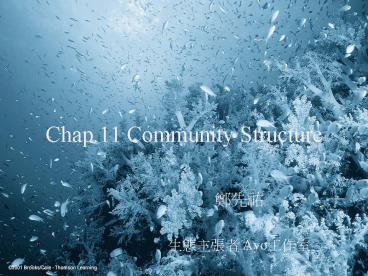Chap.11 Community Structure - PowerPoint PPT Presentation
1 / 38
Title: Chap.11 Community Structure
1
Chap.11 Community Structure
- ???
- ????? Ayo???
2
Community Structure
- Equilibrium views
- Predation as a structuring force
- Non-equilibrium views
- Tallgrass prairie, Bison, and Fire A synthesis
- Environmental Application (niche specialization
and extinction)
3
Introduction
- Community
- Guild, a group of coexisting, ecologically
similar organisms. - Adaptive radiation of Cichlid fish in Lake
Malawi, East Africa (Fig 11.1) - Size relationships among granivorous rodents in
three desert communities in the American
Southwest (Fig. 11.2)
4
Fig. 11.1 Adaptive radiation of Cichlid fish in
Lake Malawi, East Africa
5
Fig. 11.2Size relationships among granivorous
rodents in three desert communities in the
American Southwestniche ????
6
Equilibrium views
- Inter-specific competition as a structuring
- Changes in niche dimensions
- Fundamental niche and realized niche.
- Five similar species of warblers foraging in the
same tree (Fig. 11.3 and 11.4)
7
Fig. 11.3 The five species of warblers. Note the
similarity in size and bill shape.
8
Fig. 11.4 Feeding positions of five sympatric
warblers.
9
Fig. 11.4 Feeding positions of five sympatric
warblers.
10
??diversity?????
- Increased niche overlap
- Decreased niche breadth
- Increased range of resources utilized.
11
(No Transcript)
12
Niche specialization and extinction
- A highly specialized niche makes a species
vulnerable to competitive effects, particularly
from exotic species introduced into the habitat. - The bird faunas of island systems like the
Hawaiian island exemplify this problem. - Originally, the Hawaiian islands supported 84
species of endemic birds.???honeycreeper species
????radiation,?47?????18??????????,??8????????????
??????20??????
13
?11B-1. The diversity of honeycreeper species
found on the Hawaiian islands.
14
Predation as a structuring force
- R. T. Paine (1966) studied the communities of
invertebrates and algae in the rocky intertidal
zone at Neah Bay, Washington (Fig. 11.7). - This system is composed of a large group of
invertebrates and algae, with a single top
carnivore, the starfish, Pisaster ochraceous. - ??starfish ??,??????15?,?????8 ??
- Keystone predator hypothesis.
??
15
Fig. 11.17 The rocky inter-tidal community.
16
??Kangaroo rats in a desert
- ??kangaroo rats ,??12??
- ????????(?11.18)?
- Annual and perennial grasses colonized and
increased three fold in the removal plots (Fig.
11.9).
17
?11.18 ???????kangaroo rats???????????????
18
?11.19 Effects of kangaroo rat (Dipodomys)
removal from enclosures.
19
Non-equilibrium views
- In the past 20-years, ecologists have come to
suspect that most of the time, most populations
and communities are not at equilibrium. - If change in the community is frequent and
devastating, process such as competition and
predation will be less important as determinants
of community structure. - Disturbance and Patch dynamics models
20
The Role of disturbance
- Abiotic factors such as fire, volcanic eruptions,
floods, and storms have different impacts on the
various species in a community and thus affect
community organization.
21
??bird community
- Wiens and Rotemberry (1980) study the bird
community structures in the Great Basin.
??????????consistent community composition,??????,
so much variation among sites and among years
within a site ????????community composition? - The severe and unpredictable climate
characteristic of the Great Basin prevents the
local species assemblages from achieving full
ecological saturation and resource limitation.
22
Intermediate disturbance
- J. H. Connell (1979) introduced the intermediate
disturbance hypothesis to explain the number of
species coexisting in a community. (Fig. 11.23) - At low levels of disturbance, competition or
predation processes Connell termed compensatory
mechanisms reduces species diversity.
23
Fig. 11.23 Connells intermediate disturbance
hypothesis. The number of species in a community
is maximal at intermediate levels of disturbance.
24
Patch dynamics models
- The models emphasis the following properties of
communities - 1. Spatial variation in the nature of the
community. - 2. Movement between patches via dispersal of
individuals. - 3. Disturbance as an important feature of
communities.
25
Three mechanisms
- 1. Functional relationships between species
counteract biologically induced instability. - 2. Environmental disturbance decreases the effect
of biotic instability. - 3. Species have compensatory mechanisms that
operate at low population densities to prevent
extinction.
26
DeAgelis and Waterhouse (1987)
- 4. The isolation of subpopulations determines the
degree to which dispersal can lead to
repopulation of extinct patches. - 5. Spatial hetrogeneity in physical and
biological factors leads to movement of
individuals to obtain important resources. - (Fig. 11.24)
27
(No Transcript)
28
??mussel community
- The structure os the community over time is
determined by the combined forces of competitive
interactions and physical disturbance. (Fig.
11.25) - Disturbance is sufficiently frequent that the
community is a mosaic of local sites, each with a
slightly different disturbance and competitive
history.
29
(No Transcript)
30
??fossil mammal faunas
- Graham and colleagues (1996) analyzed fossil
mammal faunas from 2945 sites in the US. - The fossil record shows that most modern
communities emerged very recently. - These data support the Gleasonian view of
communities as random, nonequilibrium assemblages
of species.
31
Tall grass Prairie, Bison, and Fire A synthesis
- Deterministic biotic factors such as competition
and predation - Stochastic influences such as disturbance
- The tall grass prairie of North American occupied
some 68 million hectares before Europeans
arrived. - C4 grasses, and C3 forbs, and with fire
- Bison numbering between 30 and 60 million.
- Fig.11.26, 11.27
32
(No Transcript)
33
(No Transcript)
34
- ??????,fire frequency ??,??C4 grasses
??????C3??????(Fig. 11.28) - ??????????(Fig. 11.29)
- The mechanism for this effect is shown in Figure
11.30. - Bison preferentially select burned areas because
of their preference for C4 grasses. - Grazing reduces the dominance of these species
and allows the C3 forbs to increase in numbers. - The largest numbers of species were found in
plots that were grazed or grazed and burned (Fig.
11.29). - Bison are considered to be keystone species in
this system.
35
(No Transcript)
36
(No Transcript)
37
(No Transcript)
38
- ?????!
ayo_at_faculty.pccu.edu.tw Ayo
??? http//faculty.pccu.edu.tw/ayo































